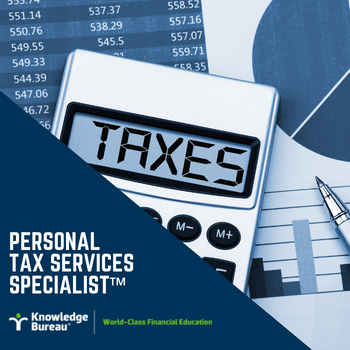The Speed of Tax Change - How to Protect Your Clients

Prepare to defend your clients against tax risk emanating from increasing CRA audit activity. Then, take a detailed look at the long and convoluted road to tax change that has resulted substantive change in how your clients report income, deductions, credits and exercise their appeal rights. Knowledge Bureau’s new Audit Defence Course is now available online and features interesting perspectives from some of Canada’s leading tax experts. In focus: independent business owners, which could include you.
We know that there are roughly 3 million incorporated and unincorporated businesses in Canada within that number and likely some rental property owners who eliminate income due to capital cost allowance claims. There may also be zero income returns due to loss carry backs and the application of minimum taxes and other provisions.
However, as you know, there a has been a shock to our economic system and in particular to self-employment. For example, in October 2021, 13.6% of workers w ere self-employed, down 1.6 percentage points from the same month in 2019.
ere self-employed, down 1.6 percentage points from the same month in 2019.
Just over half of self-employed workers do not own an incorporated business and nearly three-quarters of the decline in self-employment since October 2019 (-225,000; -10.9%) has been among the self-employed without paid help (not seasonally adjusted).
This is a significant decline. Self employment in our economy has reached its lowest level since 2007.
The bottom line is that there is new opportunity in unpacking these trending demographics, how they impact your client base and your business venture, and in particular, what can be done to delivery tax relief against new income reporting patterns in these changing economic times.

AUDIT DEFENCE: MANAGING TAX RISK FOR BUSINESS OWNERS
TABLE OF CONTENTS
CHAPTER 1: 2022 TAX COMPLIANCE ISSUES
We will overview the transition of COVID relief provisions to a new type of government support: inflation protection, especially for lower income earners.
We will take a detailed look at the long and convoluted road to tax change that has resulted in draft legislation for some but not all the provisions government has announced over the last several years. In fact, in looking closely at the new tax law, we find that how your clients report income, deductions, credits and exercise their appeal rights within our tax system has undergone substantive change.
CHAPTER 2: REMUNERATION STRUCTURES IN OWNER-MANAGED FIRMS
While most owner-manager compensation plans and planning will be discussed in depth in the Knowledge Bureau course, Tax Planning for Corporate Owner-Managers, this chapter will focus on how to report these items in the context of the payroll cycle.
Owner/managers have special payroll needs that arise because of the various ways in which compensation flows to the owner and family members involved in the business: employment income, group insurance, shareholder loans, IPPs, RRSPs, RCAs, dividends, key man insurance, and non-competition payments.
CHAPTER 3: BASIC ACCOUNT ANALYSIS – BALANCE SHEET AND INCOME STATEMENT
This chapter is an introduction to the various formats that are used in analyzing an account. The student will learn how to identify where the various formats are best used, and preparation of a basic account analysis for balance sheet, revenue and expense accounts. They will also learn how to present an account analysis in formats that are suitable for both business owners and external accountants.
The issues that are most commonly of interest in the various types of account analysis, including comparing actual results to budget and assigning budget responsibility, as well as the types of accounts that management accountants are most commonly called upon to analyze.
CHAPTER 4: BUDGETING BASICS – THE YEAR AHEAD
An introduction to the concept of budgeting with the importance of familiarity with a company’s key functions and processes, in the preparation of the budget, and the roles that the various stakeholders, such as the accounting function and Management, play in the budgeting process.
The student will learn the external elements that impact the budgeting process, including the political, economic, social, and technological environments, and how to identify areas that should be considered. The types of assumptions that typically need to be made during the budgeting process will be discussed in this chapter.
CHAPTER 5: CASH FLOW BUDGETING
The student will be able to differentiate between budgeting for operations and budgeting for cash flow. They will learn how to identify the adjustments that are typically required to be made to an operational budget in order to produce a cash flow budget. Techniques that are commonly employed in managing accounts receivable and accounts payable, in terms of managing cash flow will be discussed in this chapter, as well as the various ways in which cash flows can be analyzed and how to prepare cash flow budgets in these various formats. The student will learn the most appropriate format for users of budget financial information.
CHAPTER 6: FINANCIAL DECISION-MAKING
The student will learn how to identify the various reports that relate to the periods of the accounting cycle, with an emphasis on monthly and annual reporting of actual results against budget. Management reports that might be useful include bank reconciliations, aged accounts receivable and payable listings, inventory, fixed asset continuity schedules, sales reports, production reports, margin analysis, and comparison of actual results to budget. The importance of the user perspective, in relation to financial reports and budgets and the opportunity for an accounting function to add value will also be discussed in this chapter.
CHAPTER 7: VALUATION APPROACHES – MARKET-BASED
There are various approaches that could be used to estimate value. This chapter will explore some of the valuation approaches that utilize market-based information. These approaches include valuation multiples, comparable transactions, and industry indices. As with any valuation approach, there are strengths and limitations for these methods, as well as issues relating to accessing and adjusting market-based valuation information.
CHAPTER 8: CREDITOR AND BANKRUPTCY PROTECTION
Because so many entrepreneurs do not have a pension plan to rely upon, they often look to the sale of their business as a way to gracefully exit business and enjoy their retirement. Thus, creditors of the business who might seek monetary redress pose a serious threat to a healthy retirement strategy if a Court awards damages against the business. In some situations, the only way out is through the remedial protection of the Bankruptcy and Insolvency Act of Canada. In either instance, serious and material claims can be made against the assets of the business, thereby destroying years of careful business stewardship. It is in this context, that this module reviews the various protections that registered pension plans provide to business owners that aren’t always as robust with other types of retirement savings solutions.
Additional Educational Resources:
CONTINUING EDUCATION
DAC2022 Register by September 30; November CE Summit Register by October 14
SPECIALIZED CREDENTIALS
Register by October 31 for our Tax Efficient Retirement Income Planning certificate course.
WORKPLACE TRAINING
Register by October 31 for our Tax Efficient Retirement Income Planning certificate course.
©Knowledge Bureau, Inc. All rights Reserved